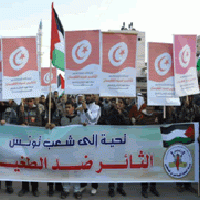Wednesday, August 10, 2017 | By Harald van Es
One swallow does not a summer make, nor one fine day; similarly one day or brief time of happiness does not make a person entirely happy. — Aristotle (384 BCE – 322 BCE)
The failure of the so-called Arab spring, a wave of revolts that swept the Arab world in a call for more democracy, is a subject that’s hardly mentioned anymore. Which in a way is remarkable, especially given the world’s initial optimism and excitement about this “new beginning” for the Arab world. At least, that was what certain Westerners wanted to believe.
Recently, the renowned Dutch weekly magazine Elsevier published an article discussing the reasons for the failure of the Arab Spring. The writer of the article, Dutch historian Geerten Waling, argues that the reason for the failure of the Arab Spring was the absence of organized opposition, leaders and democratic organizations as a viable substitution for the ruling order.
He points out that because of this lack of foundation, the several movements could not follow up on the revolts’ initial successes. To support this, he refers to the European Spring of 1848 — of which the term “Arab Spring” is an allusion — when a wave of revolts broke out in European cities during the spring months of 1848 which resulted over time in more democracy for the people.
He writes:
“The difference between the European spring of 1848 and the Arab storm is that there were underground movements with all kinds of leaders that could boost the revolutions in Paris, Berlin, Vienna and dozens of other cities to a higher level. Leaders who could conduct a public debate, with bold speeches and convincing writings, and could provide capable candidates for parliaments, who could instruct party members to play the democratic game.
Central to the revolutions of 1848 was the combination of individual, self-conscious citizens in associations that already transitioned to political parties. In debates that were parliamentary, with respect for the opposition and her views. In a political system in which everyone had equal rights, not only the people of their own clan, religion or ideology.”
This is from a Western perspective very tempting to accept as an important reason, because it reflects our way of thinking and is not entirely illogical either. However, in my view, this Western perception puts too much emphasis on one element that is less applicable to the Middle East and North Africa. Moreover, it does not take into account the several democratic and Islamic movements and groups that have played a major role at the beginning of the revolts. In fact, some of the best organized opposition groups or parties in the Arab World can be found within the Islamist movements or Brotherhoods. To look at the failure of the Arab Spring from a Western point of view results in misinterpretation of what is really the main cause of stability (or instability) in Arab politics and society.
The late Barry Rubin wrote:
“It cannot be repeated often enough that Middle East politics are not like those of other places. They make sense once one understands the region’s history, politics, and institutions, but they defy the logic that uninformed or semi-informed outsiders expect.”
We can all agree that numerous issues may have fueled the protests: concentration of wealth in the hands of autocrats and dictators, human rights issues, discrimination of minorities, corruption, economic decline and unemployment, dissatisfied youth and its refusal to accept the status quo, which have all been in some way catalysts for the revolts in the Arab world and North Africa.
However, we should also understand the realities that affected the revolts in order to understand what led to the final outcome. Or to put it more in Middle Eastern context:
“Yet everybody who knows the Middle East knows the problem is that you need to think the Middle Eastern way, not the Western way. Or perhaps to cite another Western leader, “You come with a rock, we come with a knife. You come with a knife, we come with a gun.” (from Nazis, Islamists, and the making of the Modern Middle East — B. Rubin, W.G. Schwanitz)”
First, we need to go back to one of Barack Obama’s failures in dealing with the Middle East. The originating of the Arab Spring is directly linked with Barack Obama’s views on America’s Middle East policy. In the aftermath of 9/11 and during the eight years under George W. Bush, the United States became the world’s leader in the fight against Islamic terrorism. When Barack Obama addressed the Muslim World in his famous 2009 Cairo speech, his message was meant to propose a “New Beginning” for the Muslims in the Middle East and for the US-Muslim relationship. This opportunity, proposed by an US President with a Muslim father with the middle name Hussein, was met with optimism and excitement. Speaking directly to the Arab World with members of the Islamist Muslim Brotherhood sitting at the front row (thus insulting than Egyptian president and ally, Hosni Mubarak), was a clear message to all the Arab rulers and Muslims in the Arab World. But Obama’s misunderstanding of how the Middle East works, would subsequently set off a string of failed Middle East diplomacy efforts, leading up to the Arab Spring with devastating results.
In fact, Obama would eventually make the same mistake as George W. Bush. As Barry Rubin points out,
“By rebuilding and reshaping its situation [Iraq], providing its people with good lives and democracy, he [Bush] expects to win Arab and Muslim gratitude … Obama’s supporters have ridiculed Bush for trying to remake other peoples, cultures, and countries. The same point applies to Obama.”
What Iraq was for Bush, was the Middle East for Obama. Obama’s good intentions, inspired by his leftist perspective, couldn’t remake Middle Eastern peoples, cultures, and countries as well.
The Western misconception that a regime change as result of the Arab revolts by massive popular movements of disappointed young people could eventually lead to a more democratic Middle East, was about to be proven wrong. It was not based on how the Middle East works and underestimated the Islamic, the sectarian and — more importantly — the military factor.
Islam is the main social, cultural and political factor embedded in Middle Eastern societies. With the beginning of the various revolts, Islamist groups soon emerged on the scene with their own (not the Western) understanding of democratic standard eager to optimise and exploit Islamist social and political gain. The ruling powers knew this all too well. Soon the Islamist elements within the uprisings would dominate the streets, organizing and hijacking the revolutions. On different occasions, it was only the military that had the means and the power to withstand an Islamist takeover or to reverse an Islamist dominated government.
Therefore, the first and most important reason — which leaves all other less significant — for the outcome of the uprisings was the military elite’s decision to support, influence or thwart the spontaneous or organized hybrid (democratic-islamist) revolutions. The military elite’s decision was thus crucial for the success or failure of the revolts and that decision was mostly based on the military’s assessment and ability to maintain its own interests and base of power within any new order despite all the factors that fueled the protests.
Secondly, the Sunni-Shia sectarianism is — and has been — a key factor in the violence of the Middle East. The struggle for power and theological authority divides Islam and the Arab World in two main blocs each with its own objectives. In general, Sunni muslims don’t want to be ruled by Shia rulers and Shia muslims don’t accept dominance of a Sunni caliphate. Again, this surpasses economic or other factors that fueled the protests in the first place. This religious sectarianism challenges each other in every aspect of the Islamic faith, life, structure and future. When revolts break out in countries with a mixed population of Sunni and Shia muslims (usually one of the factions on one side and the other on the rulers side) weakening the ruling government, it’s guaranteed that a civil war is on the brink, which is not what Obama had anticipated when he addressed the Muslim world. There’s no unity within Islam. Alliances and cooperation are based on sectarianism, territory, preferences, history and economic interests. This volatile aspect of the Middle East would influence the Arab Spring drastically.
The Arab Revolts swept among others through Tunisia, Egypt, Libya, Syria, Yemen and Bahrain. Similar protests took place in Morocco, Western Sahara, Iraq, Lebanon, Jordan and other countries. If we look at some cases individually, we can see a pattern here.
The Tunisian revolution — also called The Jasmine Revolution — was the first revolt which led to the ousting of a ruler. President Zine El Abidine Ben Ali officially resigned on 14th January 2011, after fleeing to Saudi Arabia. The revolt led to more freedom, new elections, a government of unity (with a dominant Islamist party) and a divided military but still capable to keep a power balance and provide stability. Eventually, new protests aroused, now diverted against an Islamist-led government. Quietly, this Islamist-interim government would fall apart due to the army’s pressure and that was the end of the Tunisia’s democratic dream: a new parliamentary republic, new constitution, but same status quo. Besides, take into account that Tunisia traditionally was and is one of the most democratically organized Muslim societies in the Arab World.
The Egyptian Revolution — also termed the Facebook-revolution — which led to the arrest and prosecution of President Hosni Mubarak (after being an Western ally for decades) and free elections. Due to immense pressure of the Barack Obama administration, the Egyptian army was reluctant to interfere with the outcome of the demonstrations. However, the Muslim Brotherhood and other Salafist groups hijacked the revolution. It resulted in an Islamist Muslim Brotherhood dominated new government with a new Islamist constitution, a devastating impact on social freedoms, Islamic pressure on women and minorities, even more economic decline and increase in Islamist terrorism in the Sinai. Eventually, the army under leadership of al-Sisi interfered in 2014, rewrote the constitution and returned to the Mubarak era status quo. End of story… for now.
The Yemen protests would lead to the mediated overthrow of Ali Abdullah Saleh followed by the restructure of Yemeni’s weakened army, resulting in the occupation of several areas of Yemeni territory by al-Qaeda (sunni) and Houthi (shia) rebels. Thus resulting in what is known as the Yemeni Crisis and leading to the Yemeni Civil War. Which in turn, triggered the Saudi Arabian-led intervention in Yemen. A shift from tribal rulers, but nothing really changed, as the people of Yemen are used to civil war, insurgency and living in one of the poorest countries in the world.
The Libyan Revolution started in the historically rebellious Benghazi area. One needs to understand that Libyan society is a conglomerate of tribes with strong local loyalties and customs. Muammar Gaddafi, with the help of a strong army and mercenaries, managed to keep Libya united since 1969 despite regional differences and tribal matters. Muammar Gaddafi was right to warn the West that these protests would not lead to more democracy, but to Islamist’ insurgency and tribal chaos. Obama and the West should have listened. Instead, they intervened in the following civil war when Gaddafi seemed to get the upperhand due to his greater military assets. Eventually, Gaddafi was captured and killed and Lybia descended into the predicted tribal and factional chaos. Now Libya is a safe haven and breeding-ground for Islamist terrorists, emerging of ISIS and human trafficking (immigrants crisis).
The Bahrain protests starts when Shia demonstrators demand more economic benefits, freedom and release of political prisoners with the backing of Iran. Bahrain has a large Shia population, but are ruled by a Sunni minority. With just a small army, Bahrain asks for and gets support from the GGC states. A contingent of GCC military units intervene on behalf of the Bahrain ruler King Hamad. Status quo preserved.
Build on pan-Arab nationalism, Syria’s ruling family — the Assad dynasty from the Alawite minority — always leaned on a strong Sunni army. When the Syrian protests started early 2011, police and army forces violently suppressed the demonstrations. Syria has a well-organized democratic movement which quickly jumped the bandwagon and called for and organized more peaceful protests. The situation dramatically turned into a civil war after Bashar Assad used all his army assets against his own civilians. Sunni army units defected to emerging Sunni rebel groups. As Syria’s population consists of Syrian Arabs (mainly Sunni), Palestinian Arabs (Sunni), Christians, Shia Muslims, Alawites (Shia sect), Syrian Kurds, Druze, the civil war exploded when several Salafi-Islamist groups entered the scene (ISIS, Al-Nusra), Hezbollah (Shia) together with more Sunni Arab rebel groups and YPG-forces (Kurds). The involvement of a number of regional countries (Iran, Turkey, Saudi Arabia, UAE, Qatar) and non-regional countries (Russia, USA-led coalition) supporting the Assad regime or any other faction, resulted in a prolonged civil war until this day.
Small protests erupted also in Algeria, Jordan, Oman, Kuwait, Morocco, Lebanon, Saudi Arabia with only minor results which had little or none impact on the ruling class or actual status quo. In all these cases, the army and the security apparatus stayed loyal to the ruling elites.
The 2009 Iranian presidential election protests — also termed the “Twitter Revolution” or “Persian Awakening” — are not widely regarded to be part of the Arab Spring, but nevertheless deserves to be mentioned here as well. The protests began the 12th of June 2009, following the announcement that President Mahmoud Ahmadinejad had won the presidential elections. All three opposition candidates claimed that the election was rigged. The massive protests were mainly in support of the opposition candidates Mir-Hossein Mousavi and Mehdi Karroubi and occurred nationwide. The Iranian government used the fanatical paramilitary Basij units, the military revolutionary guards as well as police forces to violently suppress the largely peacefull demonstrations, resulting in numerous arrests, torture of prisoners and casualties. Some reports showed evidence of the Iranian governments’ recruiting of Lebanese Hezbollah fighters to battle the protesters in the streets. The protests would continue until 2011. The Obama administration choose not to intervene on behalf of the protesters or pressure Iran during these events. Until this day, Iran remains a Shia-theocratic dictatorship, controlling the Shia majority in Iraq, supporting Bashar Assad in the Syrian civil war, promoting terrorism and undermining neighbouring Sunni states.
To summarize, the decision of the military elites would be the main factor for the final outcome of the Arab revolts, taken in account the different other factors such as the Islamist movements and the Sunni-Shia conflict. Democracy in the Middle East is only possible when the people are done fighting each other, setting aside the Sunni-Shia differences, moderating Islam, and start thinking about creating jobs, building roads and houses, and providing electricity and water. Any presence or absence of democratic movements, leaders or groups are not going to change this fact.
Arabic swallows will continue to fly in an Arabic winter for years to come.
Harald van Es is the founder and director of The CrethiPlethi Center. In daily life he is entrepreneur, consultant and business owner. He writes articles in Dutch and English on the Middle East, Israel, Revolutionary Islamism, Multiculturalism and Europe. He has lived in Jaffa (Tel Aviv), Israel. He currently lives in the Netherlands. For all the exclusive blog entries by Harald van Es, go here.



 RSS
RSS











THE CLUELESSNESS OF CLAIMING THAT OBAMA’S MIDDLE EAST POLICIES WERE A FAILURE CANNOT BE FURTHER FROM THE TRUTH, WHAT THE ARAB SPRING DID IS EXACTLY WHAT WAS PLANNED FROM THE START, REMOVAL OF ANY SECULAR AND MARGINALLY SECULAR ARAB STATE, THE FACT IS MORE THAN OBVIOUS, THE ARAB SPRING WAS AND IS THE INTIFADA AGAINST NON SHARIA COMPLIANT ARAB “INFIDEL”
STATES, INCLUDING MOB RULE OF A FASCIST ETHNIC CLEANSING MOVEMENT OF INDISCRIMINATE JIHADS AGAINST THE MOSLEMS WHO LIVE IN AND WITHIN INFIDELS, THE ONLY FACTOR THAT TIES IT ARE THE SAUDIES, THE U.N., E.U. NATO, OBAMA AND THE MOSLEM BROTHERHOOD.
I’M SURE THAT THIS WAS THE PLAN FOR A CALIPHATE THAT BOTH SUNNI AND SHIITE HAD FROM THE START.